The Proof Re-Strike and Mule Proclamation Medals Of Mexico: the story of Father Augustin Fischer and George Steele Skilton
by Kent Ponterio
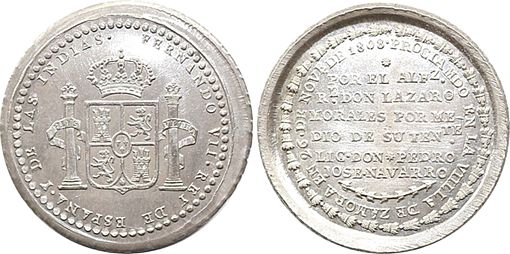
Zamora Proclamation Medal Proof Re-strike
(Image courtesy of Dan Sedwick)
Throughout history many world mints have re-struck coins from resurrected genuine dies. For instance, along with other re-strikes, the United States produced the famous 1804 Dollars, which were re-struck on multiple occasions. Russia observed similar practices by issuing Novodel re-strikes long after the originals. In some cases new dies were created when the originals were non-existent. The practice of re-striking coins to meet demand from collectors took place in many countries over the years, including Mexico in the 19th century.
I first became aware of proof re-strikes and mules of the Spanish Colonial proclamation medals while cataloguing an extensive collection in the mid 1990s. The collection came to us meticulously sorted and stored in red velvet trays, among which were two trays filled with medals that were clearly of different manufacture. Many pieces that are traditionally found with milled edges were, in this case, produced with plain edges, struck out of collar and were inconsistent in weight. Several were also on oversized planchets with uneven rims, struck on polished blanks from polished dies stuck in proof. Further, many were unpublished mules made from obverse and reverse dies from different cities. Many of the pieces remain uncatalogued in the standard references by Grove, Medina and Hererra. When I inquired about the origin of these pieces I was told they were re-strikes made for Father Fischer, the priest who was confessor to the Emperor Maximilian.
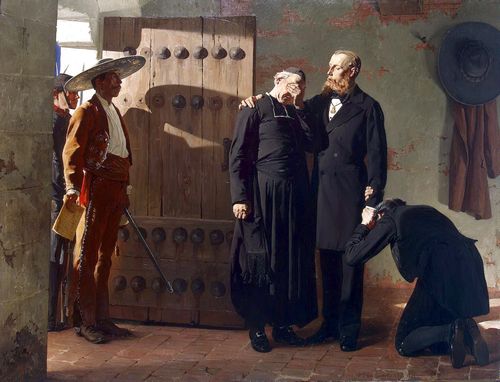
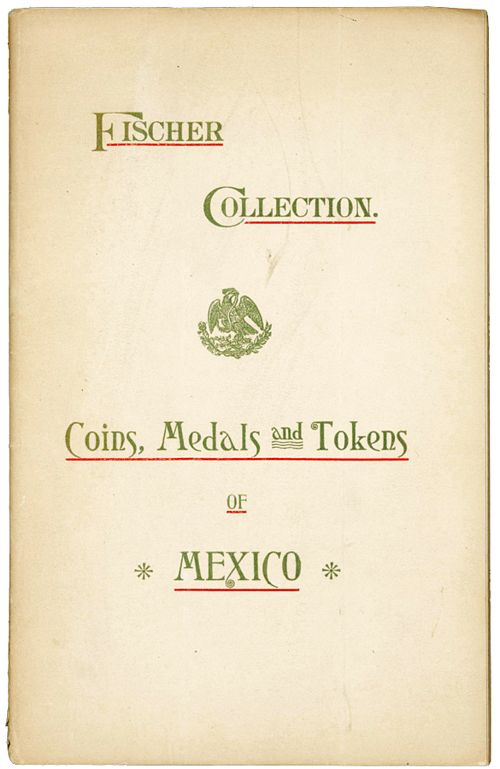
The first mention of these pieces is in the April 1891 Scott Stamp and Coin Company Ltd of New York auction of the Father Augustin Fischer Collection of Coins, Medals and Tokens of Mexico. At first the catalogue does not seem like much, as it is a small 51-page pamphlet containing some 800 lots of Mexican material. The descriptions are brief at best with only a handful of items illustrated via engravings rather than photographs. Recently I was fortunate to obtain an original copy of the catalogue from David Sklow’s January 2013 numismatic book auction. As a reference the catalogue is not of great importance, however there is a small section imbedded at the end titled “restrikes and mules” that sheds quite a bit of light on a subject that otherwise remains unexplained in Mexican numismatics. Page 48 of the catalogue is the only place that to my knowledge talks about these pieces at any length. The description is brief and contains some inaccuracy regarding dating and origin, however it sheds some insight on these pieces. The introduction to the catalogue gives a brief biography of the collector Father Fischer:
Father Fischer was born at Wurttemberg, Germany, about 1820 and died in the City Mexico in 1887. During the Empire he was Minister of the Household and a Confessor to Maximilian. He was Minister Plenipotentiary to Rome under the Emperor in 1865. He possessed one of the best Libraries of Spanish Americana in the western world, and those in correspondence with him found he had a remarkable collection of Coins.
Father Fischer’s ties to Maximilian extend far beyond the role of confessor to the emperor. He was often found in the same small social circles and was in fact imprisoned at the same time as the late emperor. The Fischer collection was purchased by Scott Stamp and Coin via private treaty in October of 1890 from a gentleman who bought the collection in Mexico. By this time parts of the collection had already been dispersed, however it still contained 50 re-strike proclamation medals, 35 of which were mules.
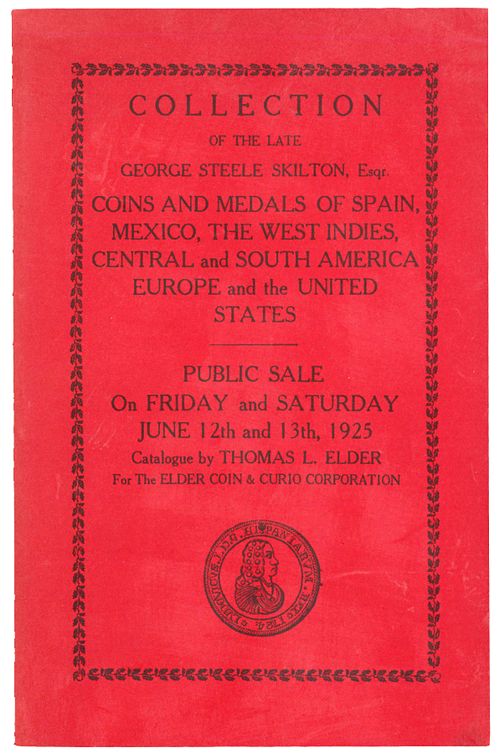 After the sale of the Fischer collection 34 years passed before there was further mention of re-strikes and mules in the numismatic literature. In June of 1925 the Elder Coin & Curio Corporation auctioned the collection of the late George Steele Skilton which is the only other catalogue I am aware of that makes mention of such pieces. The 118-page Skilton catalogue contains some 3,214 lots and is text only with no illustrations. Arranged in chronological order more than 50 proclamation medals are described as either “restrike”, “restrike proof”, “proof” or “muling” and are interspersed with the regular proclamations. George Steele Skilton was born 25 November 1845 in Troy, New York. From 1865 to 1868 he attended Rensselaer Polytechnic Institute and graduated with a degree in Civil Engineering. Following graduation he moved to Mexico and remained there until 1886. His time in Mexico was spent predominantly working in the railroad industry for the Mexican Railroad Company (1871-1872), the Mexican Central Railroad (1874-1876 and again 1880-1882) and the Sinaloa and Durango Railroad Company (1884-1886).
After the sale of the Fischer collection 34 years passed before there was further mention of re-strikes and mules in the numismatic literature. In June of 1925 the Elder Coin & Curio Corporation auctioned the collection of the late George Steele Skilton which is the only other catalogue I am aware of that makes mention of such pieces. The 118-page Skilton catalogue contains some 3,214 lots and is text only with no illustrations. Arranged in chronological order more than 50 proclamation medals are described as either “restrike”, “restrike proof”, “proof” or “muling” and are interspersed with the regular proclamations. George Steele Skilton was born 25 November 1845 in Troy, New York. From 1865 to 1868 he attended Rensselaer Polytechnic Institute and graduated with a degree in Civil Engineering. Following graduation he moved to Mexico and remained there until 1886. His time in Mexico was spent predominantly working in the railroad industry for the Mexican Railroad Company (1871-1872), the Mexican Central Railroad (1874-1876 and again 1880-1882) and the Sinaloa and Durango Railroad Company (1884-1886).
The Skilton family papers, 1845-1917, housed in the Rensselaer Polytechnic Institute archives, shed further light. The papers focus on the careers of the three Skilton brothers James, Julius and George, all natives of Troy and graduates of the Institute. All three brothers were involved with the U.S. and Mexico Claims Commission and the Mexican Consulate.
Dr. Julius Augustus Skilton graduated from the Institute in 1849 with a Bachelor of Natural Science and went on to get an A.M. from Wesleyan University and a M.D. from Albany Medical College. He practiced medicine in Troy until the outbreak of the U.S. Civil War when he enlisted as a surgeon. After the Civil War Julius traveled on assignment to Mexico for the New York Herald. He escorted Mexican President Benito Juárez back to Mexico from New Orleans and proceeded to assist with his restoration of Mexican rule. Julius was commissioned to exhume and examine the body of Maximilian before it was sent back to Austria. Julius was largely responsible for the release of Father Fischer and other members of the Austrian nobility from prison following Maximilian’s execution. He was the recipient of several gifts from Father Fischer for aiding in his release from prison, among which was a portrait of the late emperor as well as an elaborate saddle presented to the emperor by the Mexican people in 1864.

Page 48 of the 1891 Scott Stamp and Coin Catalogue of the Fischer Collection
Now the question arises as to when exactly were “the restrikes and mules” produced and for whom. While the 1891 description from the Scott Stamp and Coin catalogue above gives some insight, the information is incomplete and speculative. It is important to note that the information published in the Scott catalogue came to them third hand (at best) from the previous owner of the collection. The biography of Father Fischer from the 1891 Scott catalogue states: “To what extent his coins, medals and books were culled before they reached New York, we are unable to state.” Examination of the Skilton collection leads me to suggest that it was somewhere in the 50% range, at least for the medals. The combined number of “restrikes and mules” listed in the Fischer (1891) and Skilton (1925) auction catalogues is just over 100 pieces, roughly 50 in each collection.
In my opinion these “restrikes and mules” were neither produced in the 1880s, nor were they produced for an American collector. Rather they were struck specifically for Father Augustin Fischer sometime in the mid 1860s. His close relationship with Maximilian gave him access to the mint in order to have pieces produced for his collection. We know that after Fischer was freed from prison he gave several items to Julius Augustus Skilton in gratitude for his assistance. This might explain the “culling” of the Fischer collection mentioned in the 1891 Scott catalogue, as coins and medals were surely among those gifts. George Steele Skilton did not arrive in Mexico until sometime after his graduation from Rensselaer in 1868 and he would have acquired the medals from his brother sometime after that. Further, Father Fischer died in 1887 and George Skilton left Mexico in 1886, having not added to his collection since 1881. Thus, the suggested date of 1885 is impossible.
One thing is for certain, the “proof re-strikes” are extremely rare. In most cases they are rarer than the originals, of course with the exception of the “mules” for which originals do not exist.
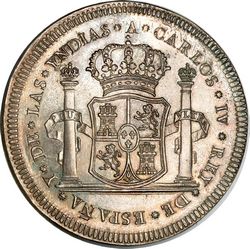
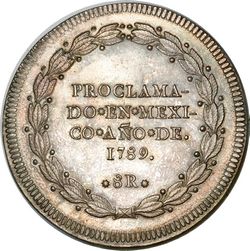
Mexico City Proclamation Medal of Charles IV Proof Re-strike
(image courtesy of Heritage Auctions)
The above pictured medal is quite interesting in terms of what evidence it provides in regards to the proof re-strikes. First, it is struck with a plain edge rather than the normal colonial edge found on this issue. Second, it is struck in the weight of 22.19gms rather than on a standard 8 Reales planchet of 27gms which is the norm for denominated proclamations of this nature. The third and perhaps most interesting factor is that the obverse is struck over a medal of the next king. Underneath the name of “CARLOS” for Charles IV is a very clear “FERNANDO” for Ferdinand VII who would not be king until nearly two decades after this medal is dated. There is no clear evidence of overstriking on the reverse. It would seem that the initial medal was a mule – Ferdinand VII obverse with a Charles IV reverse. This error must have been noticed immediately, as only the obverse die was changed during the overstrike.
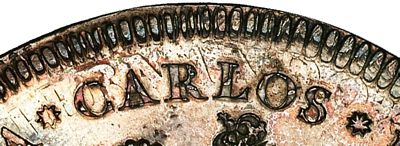
Enlargement of the Mexico City Proclamation Medal of Charles IV Proof Re-strike
The obverse is clearly struck over a later medal of Ferdinand VII
(image courtesy of Heritage Auctions)
